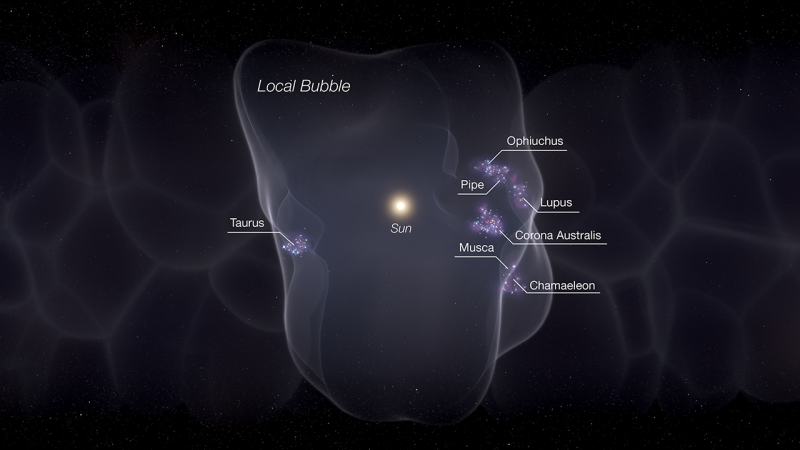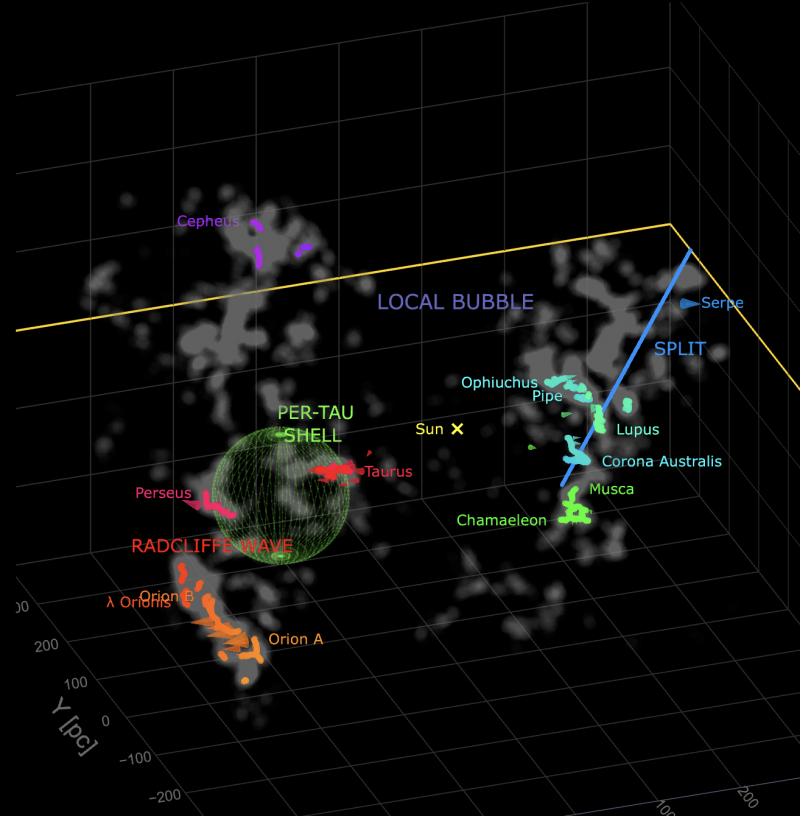
The Local Bubble
Astronomers said this week that a chain of events beginning 14 million years ago led to the creation of a vast bubble in space – presently about 1,000 light-years wide – in which our sun and thousands of other stars reside. They call it our Local Bubble. And they said this bubble’s expansion into space is responsible for the formation of all nearby young stars. They were presenting online via the American Astronomical Society, the largest U.S. group of professional astronomers. They pointed to seven well-known star-forming regions or molecular clouds – dense regions in space where stars can form – sitting on the surface of the Local Bubble. They revealed a new interactive 3D spacetime model, which lies at the heart of this new work, as well as a video explaining the concept.
The astronomers – at the Center for Astrophysics (CfA) in Cambridge, Massachusetts and the Space Telescope Science Institute in Baltimore, Maryland – were led by data visualization expert Catherine Zucker of CfA. She explained:
This is really an origin story. For the first time, we can explain how all nearby star formation began.
The researchers published their new work on January 12, 2022, in the peer-reviewed journal Nature. (Full text available at arXiv.)
You can watch recordings of the AAS press conferences here.
EarthSky 2022 lunar calendars now available! Order now. Going fast!

Expansion of the Local Bubble
It was nearly 50 years ago that astronomers first theorized that hollowed-out cavities in space – like our Local Bubble – riddled our Milky Way. And they’ve known of the existence of the Local Bubble for decades. They recognized it as a region of the galaxy sparse in the gas that pervades most of interstellar space. It’s a sort of void within the Orion Arm in our Milky Way, the spiral arm of the galaxy that contains our sun. Astronomers assumed long ago that supernovae must have exploded in this region within the past 10 to 20 million years.
The new results by Zucker and her colleagues confirm these ideas and provide a stunning visualization, showing young stars and star-forming regions within 500 light-years of Earth. These can be seen in the interactive model to sit on the surface of the Local Bubble. As the Local Bubble expands, it kicks off star formation. So the new work deepens astronomers’ understanding of our own neighborhood of the Milky Way galaxy. A statement from Zucker and her team explained:
Using a trove of new data [from the amazing Gaia space observatory] … the spacetime animation shows how a series of supernovae that first went off 14 million years ago pushed interstellar gas outwards, creating a bubble-like structure with a surface that’s ripe for star formation.
Zucker said:
We’ve calculated that about 15 supernovae have gone off over millions of years to form the Local Bubble that we see today.
The oddly-shaped bubble continues to grow, spreading outward from the supernovae that exploded millions of years ago, these astronomers note. Zucker said:
It’s coasting along at about 4 miles per second. It has lost most of its oomph though and has pretty much plateaued in terms of speed.
Strangely, we’re in the center?
Harvard professor and Center for Astrophysics astronomer Alyssa Goodman, a study co-author and founder of Glue, which is data visualization software used within the new study, said:
This is an incredible detective story, driven by both data and theory. We can piece together the history of star formation around us using a wide variety of independent clues: supernova models, stellar motions and exquisite new 3D maps of the material surrounding the Local Bubble.
Co-author João Alves, a professor at the University of Vienna, added:
When the first supernovae that created the Local Bubble went off, our sun was far away from the action. But about five million years ago, the sun’s path through the galaxy took it right into the bubble, and now the sun sits – just by luck – almost right in the bubble’s center.
Goodman mused:
What are the chances that we are right smack in the middle of one of these things?
Bubbles everywhere?
The team plans to map out more interstellar bubbles to get a full 3D view of their locations, shapes and sizes. Charting out bubbles, and their relationship to each other, will ultimately allow astronomers to understand the role played by dying stars in giving birth to new ones, and in the structure and evolution of galaxies like the Milky Way. Zucker said:
Where do these bubbles touch? How do they interact with each other? How do superbubbles drive the birth of stars like our sun in the Milky Way?
Bottom line: Astronomers have created a 3D spacetime animation showing our Local Bubble, a relative void in space filled with stars (but not much gas), blown out by supernovae millions of years ago.
Source: Star formation near the Sun is driven by expansion of the Local Bubble
Source (PDF at arXiv): Star formation near the Sun is driven by expansion of the Local Bubble
The post 1,000-light-year-wide Local Bubble drives star formation near our sun first appeared on EarthSky.
from EarthSky https://ift.tt/3K9Lgdg

The Local Bubble
Astronomers said this week that a chain of events beginning 14 million years ago led to the creation of a vast bubble in space – presently about 1,000 light-years wide – in which our sun and thousands of other stars reside. They call it our Local Bubble. And they said this bubble’s expansion into space is responsible for the formation of all nearby young stars. They were presenting online via the American Astronomical Society, the largest U.S. group of professional astronomers. They pointed to seven well-known star-forming regions or molecular clouds – dense regions in space where stars can form – sitting on the surface of the Local Bubble. They revealed a new interactive 3D spacetime model, which lies at the heart of this new work, as well as a video explaining the concept.
The astronomers – at the Center for Astrophysics (CfA) in Cambridge, Massachusetts and the Space Telescope Science Institute in Baltimore, Maryland – were led by data visualization expert Catherine Zucker of CfA. She explained:
This is really an origin story. For the first time, we can explain how all nearby star formation began.
The researchers published their new work on January 12, 2022, in the peer-reviewed journal Nature. (Full text available at arXiv.)
You can watch recordings of the AAS press conferences here.
EarthSky 2022 lunar calendars now available! Order now. Going fast!

Expansion of the Local Bubble
It was nearly 50 years ago that astronomers first theorized that hollowed-out cavities in space – like our Local Bubble – riddled our Milky Way. And they’ve known of the existence of the Local Bubble for decades. They recognized it as a region of the galaxy sparse in the gas that pervades most of interstellar space. It’s a sort of void within the Orion Arm in our Milky Way, the spiral arm of the galaxy that contains our sun. Astronomers assumed long ago that supernovae must have exploded in this region within the past 10 to 20 million years.
The new results by Zucker and her colleagues confirm these ideas and provide a stunning visualization, showing young stars and star-forming regions within 500 light-years of Earth. These can be seen in the interactive model to sit on the surface of the Local Bubble. As the Local Bubble expands, it kicks off star formation. So the new work deepens astronomers’ understanding of our own neighborhood of the Milky Way galaxy. A statement from Zucker and her team explained:
Using a trove of new data [from the amazing Gaia space observatory] … the spacetime animation shows how a series of supernovae that first went off 14 million years ago pushed interstellar gas outwards, creating a bubble-like structure with a surface that’s ripe for star formation.
Zucker said:
We’ve calculated that about 15 supernovae have gone off over millions of years to form the Local Bubble that we see today.
The oddly-shaped bubble continues to grow, spreading outward from the supernovae that exploded millions of years ago, these astronomers note. Zucker said:
It’s coasting along at about 4 miles per second. It has lost most of its oomph though and has pretty much plateaued in terms of speed.
Strangely, we’re in the center?
Harvard professor and Center for Astrophysics astronomer Alyssa Goodman, a study co-author and founder of Glue, which is data visualization software used within the new study, said:
This is an incredible detective story, driven by both data and theory. We can piece together the history of star formation around us using a wide variety of independent clues: supernova models, stellar motions and exquisite new 3D maps of the material surrounding the Local Bubble.
Co-author João Alves, a professor at the University of Vienna, added:
When the first supernovae that created the Local Bubble went off, our sun was far away from the action. But about five million years ago, the sun’s path through the galaxy took it right into the bubble, and now the sun sits – just by luck – almost right in the bubble’s center.
Goodman mused:
What are the chances that we are right smack in the middle of one of these things?
Bubbles everywhere?
The team plans to map out more interstellar bubbles to get a full 3D view of their locations, shapes and sizes. Charting out bubbles, and their relationship to each other, will ultimately allow astronomers to understand the role played by dying stars in giving birth to new ones, and in the structure and evolution of galaxies like the Milky Way. Zucker said:
Where do these bubbles touch? How do they interact with each other? How do superbubbles drive the birth of stars like our sun in the Milky Way?
Bottom line: Astronomers have created a 3D spacetime animation showing our Local Bubble, a relative void in space filled with stars (but not much gas), blown out by supernovae millions of years ago.
Source: Star formation near the Sun is driven by expansion of the Local Bubble
Source (PDF at arXiv): Star formation near the Sun is driven by expansion of the Local Bubble
The post 1,000-light-year-wide Local Bubble drives star formation near our sun first appeared on EarthSky.
from EarthSky https://ift.tt/3K9Lgdg

Aucun commentaire:
Enregistrer un commentaire